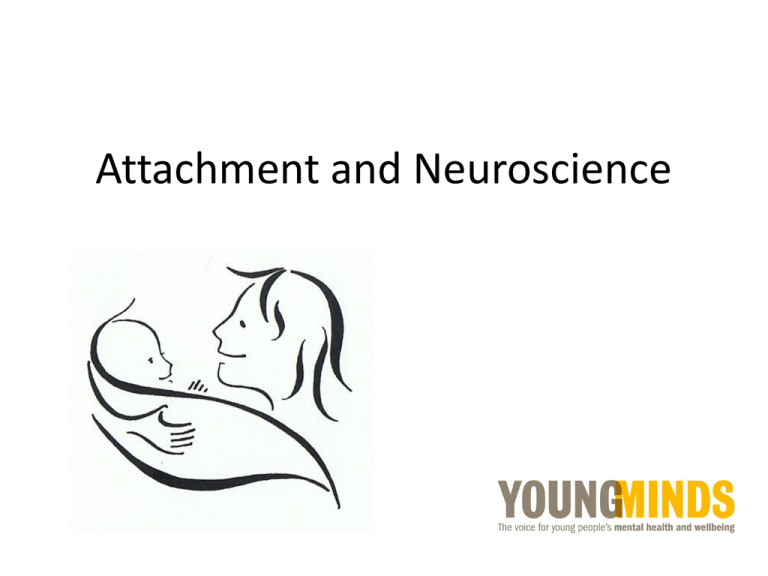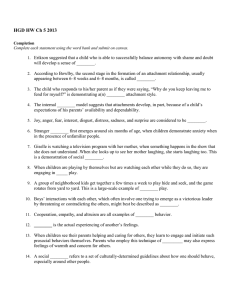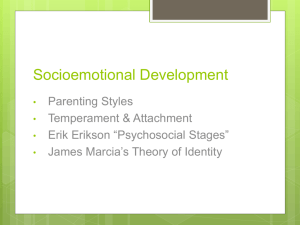Attachment and neuroscience
advertisement

Attachment and Neuroscience Attachment Theory Attachment behaviour is defined as: The seeking of protection when anxious which is triggered by external threats or behaviours The person to whom a child is attached provides a secure base, a place of safety, warmth and comfort Attachment Theory A securely attached child feels confident that should they feel anxious, their parents will respond. Such security is brought on by interactions which are: • Sensitive • Regularly available and reliable • Warm • Responsive • Consistent Way attachment develops need relaxation trust security attachment satisfy need arousal - relaxation cycle high arousal Secure and insecure attachment “A securely attached child is likely when faced with potentially alarming situations .... to tackle them effectively or seek help in doing so” Children whose needs have not been adequately met see the world as; ‘comfortless and unpredictable and they respond by either shrinking from it or doing battle with it.’ Bowlby (1980) Attachment and loss Vol. 3 and Bowlby (1973) Attachment and loss Vol. 2 Insecure Avoidant • Caregiver subtly or overtly reject child’s attachment needs at time of stress • Bids for comfort will be rebuffed • Child keeps his/her attention directed away from their caregivers in an effort not to arouse anxiety and frustration • In control because of the need for self reliance • Comfort self rather than accept it from others Insecure Ambivalent/Anxious Caregiver will be inadequate at meeting child attachment needs (caregiver is passive, unresponsive and ineffective) Child’s strategy is to amplify attachment needs and signals in an effort to arouse a response (verbal and behavioural: bubbly affection to rage, anger, panic and despair. All experienced as controlling) Unlovable and helpless selves & unpredictable and withholding others. Insecure Disorganised Child experiences the carer giver as ‘the source of alarm and its only solution’. Child in these circumstances is unable to be guided by their mental model of the world because it offers few directions. Frightened, helpless, fragile and sad At risk of mental health problems or anti-social behaviour In Essence… Attachment needs are activated during times of perceived stress (discomfort, environmental, danger, fatigue, illness) The child must either have these attachment needs met or find other ways to cope. Adolescent attachment styles Compulsive self-reliance Distrusts relationships, avoids being rejected or relied upon. Prone to depression or psychosomatic symptoms. Compulsive care giving Actively involved in relationships but always as a care giver. Own parents unable to provide care but might have demanded it from child. Care-seeking Vigilant to signs of loss or abandonment. Constantly anxious. Parents probably unresponsive or threatened to leave family. Angry withdrawal Generalised anger towards attachment figure who is seen as unavailable. Positive brain development The way a child is stimulated shapes the brain’s neurobiological structure. Experience has a direct impact on a child’s capacity for living, learning and relating as a social being. Early Brain Development We are born with most of the neurons (brain cells) we will ever own but; At birth the brain is 25% of its adult weight - by the age of 2 this has increased to 75% and by age 3 it is 90% of adult weight. This growth is largely the result of the formation and ‘hard wiring’ of synaptic connections Babies brains are both ‘experience expectant’ and ‘experience dependent’ Proliferation of synapses The Learning Years: 5-10 • Synaptic pathways that are regularly used are reinforced. This is the basis of learning. Reinforcement leads to permanent neurological pathways. • Neural connections needed for abstract reasoning are developed • Motor skills are refined Adolescent Brain Development • Brain development continues up to at least the age of 20 • There is a significant remodelling of the brain in adolescence, particularly the frontal lobes and connections between these and the limbic system • The frequency and intensity of experiences shapes this remodelling as the brain adapts to the environment in which it is functioning and becomes more efficient Emotional Functioning • There is a mismatch between emotional and cognitive regulatory modes in adolescence • Brain structures mediating emotional experiences change rapidly at the onset of puberty • Maturation of the frontal brain structures underpinning cognitive control lag behind by several years • Adolescents are left with powerful emotional responses to social stimuli that they cannot easily regulate, contextualise, create plans about or inhibit Impact of trauma In the face of interpersonal trauma, all the systems of the social brain become shaped for offensive and defensive purposes. A child growing up surrounded by trauma and unpredictability will only be able to develop neural systems and functional capabilities that reflect this disorganisation. Source: National CAMHS Support Service, Everybody’s Business Traumatic stress When children and young people experience persistent stress they are likely to produce toxic amounts of cortisol which can have a detrimental effect on Brain function All major body systems Social functioning Over production of stress hormones These functions may be diminished or lost: Ability to learn language and to speak Understanding feelings or having words to describe them Connection between how we feel and our sensory experience Empathy Control of impulse Regulation of mood Short term memory Enjoyment





